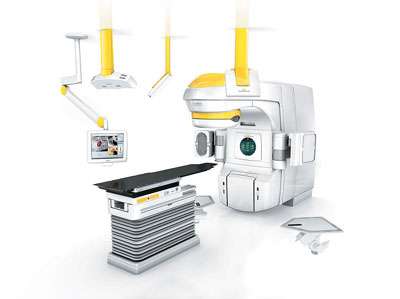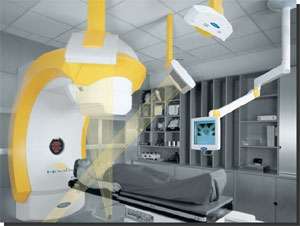Novalis Tx Technology
Find your care
Radiation oncologists use a patient-centered approach and individualized treatment plans. To learn more and make an appointment with a UCLA radiation oncologist, contact us at:
Westwood - 310-825-9775
Santa Clarita - 661-287-0010
Santa Monica - 424-259-8777
El Segundo - 310-794-7301
State-of-the-Art Technology - The NovalisTx
The Novalis Tx is a powerful radiosurgery system that offers a versatile combination of advanced technologies for the treatment of tumors and other anatomical targets. With the Novalis Tx radiosurgery platform, UCLA offers state-of-the-art, non-invasive treatment for a wide range of malignancies and other potentially debilitating conditions, without harming nearby healthy tissue and without involving traditional surgery.

Novalis Tx, installed Feb 2009, is equipped with Varians RapidArc radiotherapy technology. The Novalis Tx platform includes three imaging modalities for pinpointing the tumor and positioning the patient with high precision - an On-Board Imaging device (OBI), ExacTrac room-based image-guidance system provides continual imaging during treatment to detect movement and support robotic adjustments in patient positioning in six dimensions, and electronic portal imaging device (EPID). These methods allow for protection of surrounding healthy tissues while enabling clinicians to concentrate higher, more effective doses on tumors.
Novalis Tx will offer treatment options for an extremely wide range of indications such as malignant and benign lesions, brain metastases, arteriovascular malformations, and functional lesions. It features very high dose delivery rates, which means that treatments can be delivered very rapidly. Novalis Tx also offers dynamic fine beam shaping and non-invasive, precise frameless patient positioning for rapid and comfortable treatments.
With RapidArc radiotherapy technology, it can take less than two minutes to deliver sophisticated, IMRT-quality treatments in a single arc. By simultaneously modulating aperture shape, dose rate, and gantry speed at every angle, RapidArc treatments deliver continuously modulated dose to the entire tumor volume while sparing normal, healthy tissue.
RapidArc can deliver a complete volumetric IMRT treatment in a single rotation of the treatment machine around the patient. RapidArc software modulates the MLC aperture shape, dose delivery rate, and gantry speed throughout the rotation. In addition to being faster to deliver, RapidArc treatments are more efficient in terms of beam output, translating to less overall "scatter" and out-of-field dose to the patient. The latest version of RapidArc further supports stereotactic applications by increasing the number of monitor units that can be delivered per beam (or per gantry rotation).
More About Novalis Tx Technology
Comprehensive IGRS Select the best possible patient positioning and verification with the dual Image-Guided system: ExacTrac® X-Ray 6D & On-Board Imager.
| Novalis Tx features | Benefits |
|---|---|
| iPlan® Net | Flexible network-based infrastructure, integrating entire surgery and radiotherapy departments. |
| Frameless SRS | Greater patient comfort and greater flexibility for the clinician with proven accuracy. |
| Rapid Arc | Fast and highly precise modulation of MLC, linac speed and dose delivery in real-time. Improved dose conformality with significantly shorter treatment times. |
| Adaptive Gating | Treatment of targets subject to respiration-related movement. |
| 6D Robotic Couch | Fast and highly accurate patient positioning for translational and rotational setup in 6D. |
| High Definition 2.5-mm HD120 MLC | The high-definition beam shaper for highly precise dose conformality around the tumor. |
| High-Resolution Beam Shaping with Large Field | With 22 x 40 cm field size Novalis Tx provides high-resolution beam shaping for any radiosurgery application throughout the body. |
| 6 to 20 MV Dual Energy | Multiple energy system penetrates deeper with greater conformality for SBRT applications. |
| 1000 MU/min. Dose Rate | Highest dose rate in the industry (status July 2008) for fast treatment delivery and maximized patient throughput. |
| Cone Beam CT | Includes On-Board Imager® for 3D soft tissue target confirmation for SBRS |
| MV Portal VisionTM and Fluoroscopy | Helps you 'see what you treat while you treat' in real time |
Novalis Shaped Beam Surgery
With the installations of the world's first Novalis system for shaped beam surgery in 1997, UCLA continues in its pioneering efforts to provide the highest levels of patient care. Novalis, a dedicated system for non-invasive stereotactic radiosurgery and radiotherapy (SRS/SRT), represents cutting-edge technology for treatments of the highest precision. Novalis is equipped with "Novalis Body" software for image-guided radiotherapy delivery. Its X-ray-based localization technology allows physicians to localize tumors with sub-millimeter accuracy and to position patients automatically and with the highest degree of precision.
Shaped Beam Radiosurgery is the most advanced form of stereotactic radiosurgery. Beam shaping results in a high target conformality (better exclusion of normal tissue conforming the dose only to the intended target) as well as better dose homogeneity (i.e., no "hot or cold spots" of dose). Novalis produces a sharp radiation dose gradient at the treatment field edges resulting in a highly effective treatment of the target, while greatly reducing the dose of radiation to the surrounding healthy tissue. This non-invasive treatment can often avoid complications and inconveniences of open surgery. A treatment with Novalis typically takes less than 30 minutes.
Why is Shaped Beam Radiosurgery Better? The "old" technology utilizing multiple isocenters (left) spreads more dose to healthy tissues as well as creating hot spots within the target. Hot spots can cause necrosis (death) of normal tissue and other complications. With shaped beam technology, critical structures are better protected from the complications caused by "hot spots."
